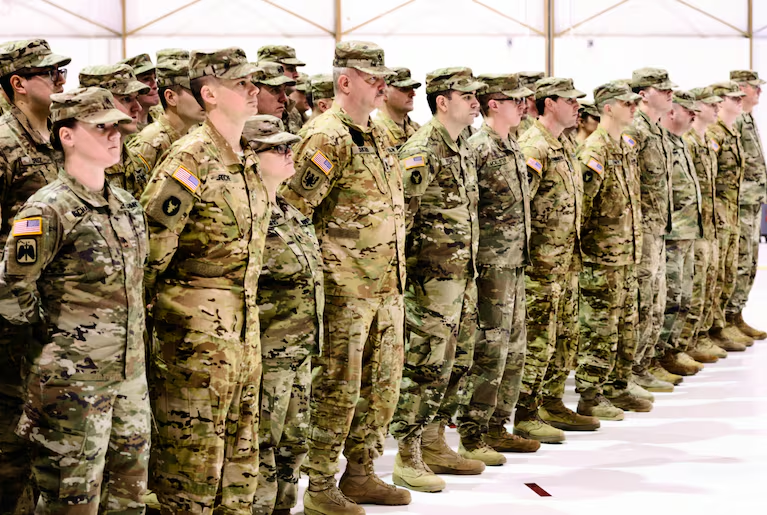PORTLAND, Ore. — The Oregon National Guard has begun mobilizing troops in response to President Donald Trump’s order to deploy 200 guard members to Portland, though officials say it could be next week before any arrive in the city.
Volunteers and Qualifications
According to Lt. Col. Stephen Bomar, director of public affairs for the Oregon Military Department, the deployment is drawing from a pool of about 300 guard members trained as military police or certified through Oregon’s police standards agency. Of those, 166 have already volunteered, primarily from along the I-5 corridor.
Before deployment, each guard member must be vetted for qualifications — a process that takes 96 hours. Some could require additional training, making Thursday the earliest possible arrival date, though Bomar cautioned that timeline was unlikely.
Also Read
“If we had everything all ready to go, the earliest would be shortly after that 96-hour mark, but I do not see that happening in this case,” Bomar said.
A Historic First
The situation is unprecedented. Trump’s order marks the first time Oregon’s National Guard has been deployed within the state over the objections of its governor. The only other presidentially ordered deployment of Oregon guard members came after September 11, 2001, when troops were sent to airports for security.
Oregon governors have previously activated the guard for civil unrest, including:
-
Four days in November 2020, during protests after George Floyd’s killing.
-
During the Rajneeshee crisis in Wasco County in the 1980s.
-
As far back as the 1896 fisherman’s strike in Astoria.
“We swear an oath to obey the orders of the President of the United States and to obey the orders of the governor of the state of Oregon,” Bomar said. “These are lawful orders until deemed otherwise.”
State Leaders Challenge Deployment
Oregon’s Democratic leaders are fighting back. Attorney General Dan Rayfield, Gov. Tina Kotek, and Portland Mayor Keith Wilson have filed a lawsuit and a motion for a restraining order, arguing Trump’s order exceeds his authority.
They contend there is no public safety crisis that justifies military intervention. U.S. District Court Judge Michael Simon is scheduled to hear oral arguments Friday.
Mission Still Unclear
So far, the Pentagon has indicated the guard’s main responsibility will be protecting federal buildings. It has not been determined whether troops will be armed or where they will be stationed. They will not assist with immigration enforcement, Bomar said.
If conditions remain calm, troops could even be stood down. “If it isn’t secure and it is chaotic, then that will also get voiced up that chain of command,” Bomar explained.
Lt. Col. Charles Patzner will command the contingent, working with U.S. Northern Command to determine assignments.
City Officials Left Waiting
Local officials say they are still in the dark about how the deployment will unfold. Portland Police Chief Bob Day said his bureau has received no information about tactics or coordination.
Day pointed to the unexplained presence of a helicopter circling above Portland’s ICE facility over the weekend. “I have no details on the helicopter,” Day said. “I hear it as well but I have no details on that.”
Separately, the FBI reported it had searched a home linked to a suspect accused of pointing a laser at a Customs and Border Protection helicopter. Agents recovered the laser and arrested four people, later transferred to ICE custody.
Protests and Policing Strategy
Protests outside the ICE facility grew over the weekend following Trump’s announcement. On Sunday, counter-protesters also appeared, and Portland police arrested two individuals — a 17-year-old for misdemeanor assault and a 38-year-old for felony assault.
Day emphasized that current demonstrations differ sharply from the unrest of 2020, when nightly protests lasted more than 100 days and often devolved into violent clashes with law enforcement.
Today, PPB relies more on bicycle officers in bright yellow shirts who make targeted arrests before leaving quickly. The bureau also deploys “dialogue officers” in white shirts who attempt to de-escalate tensions.
“It is a totally different landscape,” Day said. “Even though we had some disturbances at the facility, after some quick, targeted arrests, it quickly dissipated and that was the end of the story.”
Misperceptions and Political Narratives
Despite local officials’ insistence that the situation is relatively contained, images circulating on social media — often from 2020 — continue to portray Portland as chaotic.
Beaverton Mayor Lacey Beaty pushed back on that narrative, accusing Trump of relying on outdated footage to justify military intervention.
“The president cannot watch footage from over a half-decade ago and believe this is the Portland that we’re standing in today,” Beaty said.
A U.S. Army veteran herself, with a husband serving in the Oregon National Guard, Beaty said local leaders know best: “We’re the level of government closest to our people. Listen to the people who know our community the best.”
Looking Ahead
With the lawsuit pending and troops preparing, Portland faces an uncertain week. Local leaders argue the deployment is unnecessary and inflammatory, while federal officials insist it is lawful and needed to secure federal property.
For now, Portland police plan to continue their own restrained approach. “We’re going to stay fixed on our goals,” Chief Day said, adding that while federal intervention may complicate matters, his bureau will maintain consistency.
Whether or not 200 guard members ultimately take to Portland’s streets, the standoff highlights the tension between federal authority and local control — and the lingering scars of 2020 that continue to shape Portland’s present.












